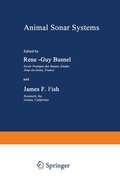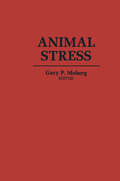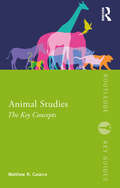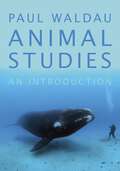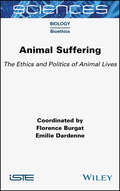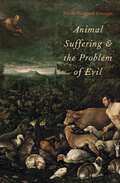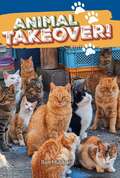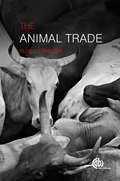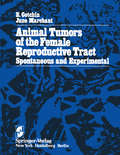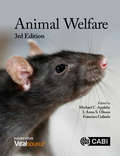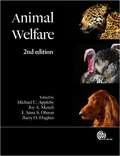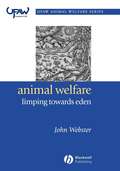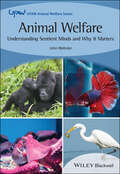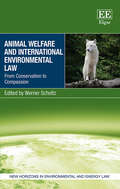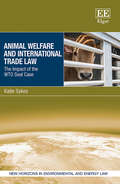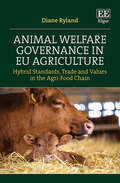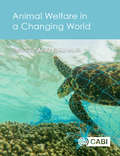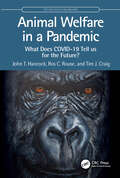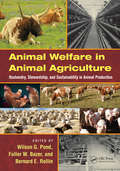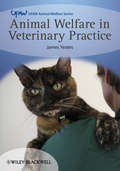- Table View
- List View
Animal Sonar Systems (Nato ASI Subseries A: #28)
by R. BusnelThirteen years have gone by since the first international meet ing on Animal Sonar Systems was held in Frascati, Italy, in 1966. Since that time, almost 900 papers have been published on its theme. The first symposium was vital as it was the starting point for new research lines whose goal was to design and develop technological systems with properties approaching optimal biological systems. There have been highly significant developments since then in all domains related to biological sonar systems and in their appli cations to the engineering field. The time had therefore come for a multidisciplinary integration of the information gathered, not only on the evolution of systems used in animal echolocation, but on systems theory, behavior and neurobiology, signal-to-noise ratio, masking, signal processing, and measures observed in certain species against animal sonar systems. Modern electronics technology and systems theory which have been developed only since 1974 now allow designing sophisticated sonar and radar systems applying principles derived from biological systems. At the time of the Frascati meeting, integrated circuits and technol ogies exploiting computer science were not well enough developed to yield advantages now possible through use of real-time analysis, leading to, among other things, a definition of target temporal char acteristics, as biological sonar systems are able to do. All of these new technical developments necessitate close co operation between engineers and biologists within the framework of new experiments which have been designed, particularly in the past five years.
Animal Stress
by Gary P. MobergBased on a recent symposium that brought together experts in behavior, nutrition, physiology, immunology, and human and animal medicine, this volume presents an up-to-date discussion of the problems and methods of studying animal stress today. Section one reviews the evolutionary and ontogenetic determinants of animal suffering and the assessment of well-being. The second section examines biological responses to stress and methods of monitoring stress in animals. Section three shows how stress can threaten animal health, disrupt normal reproduction, and influence growth and metabolism. The final section relates the importance of animal stress to developing guidelines on the use of animals in scientific research. This is an invaluable reference for exploring these complex responses
Animal Studies: The Key Concepts (Routledge Key Guides)
by Matthew R. CalarcoPrefaced with a brief introduction to the field of animal studies, the text explores the key influential terms, topics and debates which have had a major impact on the field, and that students are most likely to encounter in their animal studies classes. Animal Studies provides a guide to key concepts in the burgeoning interdisciplinary field of animal studies, laid out in A-Z format. While Human–Animal Studies and Critical Animal Studies are the main frameworks that inform the bulk of the writings in animal studies and the key concepts discussed in the volume, other approaches such as anthrozoology and cognitive ethology are also explored. The entries in the volume attend to the differences in ongoing debates among scholars and activists, showing that what is commonly called “animal studies” is far from a unified body of work. A full bibliography of sources is included at the end of the book, along with an extensive index. The book will be a valuable guide to undergraduate and postgraduate students in geography, philosophy, sociology, anthropology, women’s studies, and other related disciplines. Seasoned researchers will find the book helpful, when researching topics outside of their specialization. Outside of academia, it will be of interest to activists, as well as professional organizations.
Animal Studies: The Key Concepts (Routledge Key Guides)
by Matthew R. CalarcoPrefaced with a brief introduction to the field of animal studies, the text explores the key influential terms, topics and debates which have had a major impact on the field, and that students are most likely to encounter in their animal studies classes. Animal Studies provides a guide to key concepts in the burgeoning interdisciplinary field of animal studies, laid out in A-Z format. While Human–Animal Studies and Critical Animal Studies are the main frameworks that inform the bulk of the writings in animal studies and the key concepts discussed in the volume, other approaches such as anthrozoology and cognitive ethology are also explored. The entries in the volume attend to the differences in ongoing debates among scholars and activists, showing that what is commonly called “animal studies” is far from a unified body of work. A full bibliography of sources is included at the end of the book, along with an extensive index. The book will be a valuable guide to undergraduate and postgraduate students in geography, philosophy, sociology, anthropology, women’s studies, and other related disciplines. Seasoned researchers will find the book helpful, when researching topics outside of their specialization. Outside of academia, it will be of interest to activists, as well as professional organizations.
Animal Studies: An Introduction
by Paul WaldauAnimal studies is a growing interdisciplinary field that incorporates scholarship from public policy, sociology, religion, philosophy, and many other areas. In essence, it seeks to understand how humans study and conceive of other-than-human animals, and how these conceptions have changed over time, across cultures, and across different ways of thinking. This interdisciplinary introduction to the field boldly and creatively foregrounds the realities of nonhuman animals, as well as the imaginative and ethical faculties that humans must engage to consider our intersection with living beings outside of our species. It also compellingly demonstrates that the breadth and depth of thinking and humility needed to grasp the human-nonhuman intersection has the potential to expand the dualism that currently divides the sciences and humanities. As the first holistic survey of the field, Animal Studies is essential reading for any student of human-animal relationships and for all people who care about the role nonhuman animals play in our society.
Animal Studies: An Introduction
by Paul WaldauAnimal studies is a growing interdisciplinary field that incorporates scholarship from public policy, sociology, religion, philosophy, and many other areas. In essence, it seeks to understand how humans study and conceive of other-than-human animals, and how these conceptions have changed over time, across cultures, and across different ways of thinking. This interdisciplinary introduction to the field boldly and creatively foregrounds the realities of nonhuman animals, as well as the imaginative and ethical faculties that humans must engage to consider our intersection with living beings outside of our species. It also compellingly demonstrates that the breadth and depth of thinking and humility needed to grasp the human-nonhuman intersection has the potential to expand the dualism that currently divides the sciences and humanities. As the first holistic survey of the field, Animal Studies is essential reading for any student of human-animal relationships and for all people who care about the role nonhuman animals play in our society.
Animal Suffering: The Ethics and Politics of Animal Lives
by Florence Burgat Emilie DardenneThis interdisciplinary volume deals with the most painful situations encountered by animals in the wild or under human guardianship. It seeks to illustrate some remarkable cases and present a general picture of the commodification of animals. This volume starts with an exploration of the capture of animals intended for European zoological parks, the treatment of animals in South Korea, pig farming in China and animal testing in Europe. It goes on to explore animal politics, with a focus on Europe. The moral problems posed by the different types of harm caused to animals are then approached from the vantage point of moral philosophy. Finally, the points of view of veterinary sciences and applied ethics related to animal emotions, suffering and death complete the picture.
Animal Suffering: The Ethics and Politics of Animal Lives
by Florence Burgat Emilie DardenneThis interdisciplinary volume deals with the most painful situations encountered by animals in the wild or under human guardianship. It seeks to illustrate some remarkable cases and present a general picture of the commodification of animals. This volume starts with an exploration of the capture of animals intended for European zoological parks, the treatment of animals in South Korea, pig farming in China and animal testing in Europe. It goes on to explore animal politics, with a focus on Europe. The moral problems posed by the different types of harm caused to animals are then approached from the vantage point of moral philosophy. Finally, the points of view of veterinary sciences and applied ethics related to animal emotions, suffering and death complete the picture.
Animal Trade, The: Evolution, Ethics and Implications
by Clive PhillipsTrade is an inevitable part of human activity and evolution, but when it involves animals there are important ethical issues that have to be considered. Animal trade is often for economic reasons only, and may be hard to justify ethically. There are significant welfare and environmental costs to animals and human society that must be carefully evaluated before such a trade is sanctioned. Controversial and thought-provoking, this text focuses on the trade in live and dead animals and animal parts. It examines the facts and figures to quantify the scope of the animal trade, concentrating mainly on farm animals, but also covering captive wildlife and companion animals. The book describes welfare, environmental, economic and cultural issues around this trade, debating important ethical considerations for everyone that uses or is otherwise involved with animals, especially people in animal welfare.
Animal Tumors of the Female Reproductive Tract: Spontaneous and Experimental
by E. Cotchin J. MarchantThe chapters which comprise this book were prepared as part of a medical text, Pathology of the Female Genital Tract, which is intended for the obstetrician, gynecologist, and medical pathologist. In that context, we were con cerned to bring out the importance of the study of tumors of the female reproductive tract of animals, both as show ing the variety of spontaneous neoplasms that might affect the tract and as providing tumors capable of experimental reproduction. These chapters are published separately, since they contain information which may appeal to a range of readers who might not necessarily wish to acquire the full medical text-for example, to veterinary and comparative pathologists, cancer research workers, research workers in gynecology, experimental pathologists and endocrinologists, and possibly to others using animals in experimental and pharmaceutical studies. The survey of spontaneous tumors of the female repro ductive tract is largely concerned with tumors of the ovaries and uterus of domesticated animals, but attention is also given to laboratory animals, wild animals, and animals in zoos. The spontaneous tumors are well worth studying, not only because of their obvious clinical impor tance to veterinarians, but also because they might provide a stimulus for epidemiologic, etiologic, biologic, and ther apeutic investigations that may elucidate some of the problems related to their counterparts in humans.
Animal Welfare
by Michael Appleby Richard Bennett Dominique Blache Alain Boissy Charlotte C. Burn Dr Andrew Butterworth Michael Cockram Grahame Coleman Richard B D’Eath Ian J.H. Duncan Professor Cathy M Dwyer Paul Flecknell David Fraser Francisco Galindo Paul Hemsworth Stella Maris Huertas Barry Hughes Bryan Jones Linda Keeling Joergen B. Kjaer Ute Knierim Ilias Kyriazakis Shane K. Maloney Georgia Mason Joy Mench Professor Michael Mendl Ruth C Newberry Christine Nicol Birte L. Nielsen Anna Olsson Edmond A. Pajor Clare Palmer Jeffrey Rushen Peter Sandøe Sally L. Sherwen Marek Spinka Claudia Terlouw Paul Thompson Bert Tolkamp Ignacio Viñuela-Fernández Natalie K. Waran Daniel M Weary Francoise Wemelsfelder Nadja Wielebnowski Hanno Würbel Paul HockingUpdated and revised, this bestselling textbook continues to provide a broad introduction to the key topics in the welfare of animals both large and small, farm and companion, wild and zoo. It retains all the popular features of the previous editions with coverage of key issues such as ethics, animal pain and injury, health and disease, social conditions, and welfare dilemmas and problems. Importantly, it also offers practical advice for welfare assessment, with a full section dedicated to the implementation of solutions. The third edition: - Contains many more examples of welfare issues in different countries, particularly the implications for smallholders as well as larger scale agriculture - Covers fish welfare as well as welfare of amphibians, reptiles and invertebrates - Includes concepts of positive emotion and other positive aspects of welfare - Focuses on animal welfare and sustainability - Includes an integrated ebook with additional material and videos With contributions from renowned international experts and a new editorial team, Animal Welfare, 3rd Edition is an essential resource for students and researchers in animal and veterinary sciences and other disciplines considering the science and practice of animal welfare, and for practitioners and decision-makers worldwide.
Animal Welfare
by Michael C. Appleby Barry O. Hughes Joy A. Mench I. Anna S. OlssonThe welfare of animals continues to increase in recognition and concern throughout the world, with more and more research in the field offering new insights into the optimal conditions and treatment for the animals we live and work with. Providing a broad introduction to the key topics in the welfare of animals large and small, farm and companion, wild and zoo, this fully updated textbook covers ethics, animal pain and injury, health and disease and social conditions, welfare issues and problems, their assessment, and solutions. With contributions from renowned international experts Animal Welfare, 2nd Edition is an essential resource for students and researchers in animal and veterinary sciences.
Animal Welfare: A Practical Approach to Redressing the Problem of Our Dominion Over the Animals
by John WebsterThere has been a recent explosion of active concern in matters of animal welfare. The science behind animal welfare has progressed significantly, new codes of practice and legislation have come into to being, and innovative methods to assess welfare schemes for food production have emerged. Part of a major animal welfare series, Animal Welfare: Limping Towards Eden is John Webster’s new and groundbreaking work on animal welfare. Building on his first book, the highly acclaimed Animal Welfare: A Cool Eye Towards Eden, it not only critically reviews areas of development, but looks to how animal welfare can be improved in the future. Special consideration is given to: Defining animal welfare (‘fit and happy’) and establishing a systematic approach for its evaluation (the ‘five freedoms’); Providing a sound ethical framework that affords proper respect to animals within the broader context of our duties as citizens to the welfare of society; Developing comprehensive, robust protocols for assessing animal welfare and the provisions that constitute good husbandry; Introducing an education policy that will increase human awareness of animal welfare problems and promote action to reduce suffering. This book is part of the UFAW/Wiley-Blackwell Animal Welfare Book Series. This major series of books produced in collaboration between UFAW (The Universities Federation for Animal Welfare), and Wiley-Blackwell provides an authoritative source of information on worldwide developments, current thinking and best practice in the field of animal welfare science and technology. For details of all of the titles in the series see www.wiley.com/go/ufaw.
Animal Welfare: Understanding Sentient Minds and Why It Matters (UFAW Animal Welfare)
by John WebsterAnimal Welfare An Accessible Overview of the Concept of Sentience Throughout the Animal Kingdom and Why It Matters to Humans Animal Welfare explores the concept of sentience and the development of sentient minds throughout the animal kingdom. The work provides improved definitions and analysis of the ideas of sentience, cognition, and consciousness, along with evidence of advanced mental formulation in birds, fish, and invertebrates. Considerations between humans and animals are also discussed, such as outcome-based ethics in relation to humans’ duties of care and the rights and wrongs of domestication. The work is divided into three parts and covers key topics such as: Specifics of animal sentience, from pain and suffering, to fear and dread, all the way to animals’ social life and the comfort/joy/hope/despair they experience What we know about the sentience of different classes of animals in the waters, air, savannah/plains, and forests Considerations on human interactions based on animal sentience, including death (killing), animal farms, animals in laboratories, wild animals in captivity, and animals in sports and entertainment Analysis on what humans can learn from animals based on what we know about their varying levels of sentience Animal Welfare serves as an invaluable analysis of animal sentience for students, teachers, and professionals directly involved in the study, teaching, and applications of animal behavior, motivation, and welfare. Thanks to the wide-ranging implications of animal sentience, the work will also appeal to everyone with a broader interest in animal behavior and human/animal interactions.
Animal Welfare: Understanding Sentient Minds and Why It Matters (UFAW Animal Welfare #3)
by John WebsterAnimal Welfare An Accessible Overview of the Concept of Sentience Throughout the Animal Kingdom and Why It Matters to Humans Animal Welfare explores the concept of sentience and the development of sentient minds throughout the animal kingdom. The work provides improved definitions and analysis of the ideas of sentience, cognition, and consciousness, along with evidence of advanced mental formulation in birds, fish, and invertebrates. Considerations between humans and animals are also discussed, such as outcome-based ethics in relation to humans’ duties of care and the rights and wrongs of domestication. The work is divided into three parts and covers key topics such as: Specifics of animal sentience, from pain and suffering, to fear and dread, all the way to animals’ social life and the comfort/joy/hope/despair they experience What we know about the sentience of different classes of animals in the waters, air, savannah/plains, and forests Considerations on human interactions based on animal sentience, including death (killing), animal farms, animals in laboratories, wild animals in captivity, and animals in sports and entertainment Analysis on what humans can learn from animals based on what we know about their varying levels of sentience Animal Welfare serves as an invaluable analysis of animal sentience for students, teachers, and professionals directly involved in the study, teaching, and applications of animal behavior, motivation, and welfare. Thanks to the wide-ranging implications of animal sentience, the work will also appeal to everyone with a broader interest in animal behavior and human/animal interactions.
Animal Welfare and International Environmental Law: From Conservation to Compassion (New Horizons in Environmental and Energy Law series)
by Werner ScholtzAt a time when the planet’s wildlife faces countless dangers, international environmental law continues to overlook its evolving welfare interests. This thought-provoking book provides a crucial exploration of how international environmental law must adapt to take account of the growing recognition of the intrinsic value of wildlife. Animal Welfare and International Environmental Law offers compelling and timely arguments in favour of wildlife’s inherent worth and proposes a progressive development of the law in response to its needs and interests. Taking into account recent trends in bioethics and conservation, these critical discussions of wildlife welfare have dramatic implications for the future of sustainable development and sustainable use. The book challenges assumptions by taking a perspective which decentres the needs of humans and instead emphasises the growing need to protect wildlife with compassion and care. This book will prove invaluable to both students and scholars of environmental law, animal law and international law more widely. It will also appeal to policymakers, legal scholars and NGOs dealing with the imminent needs of the earth’s wildlife.
Animal Welfare and International Trade Law: The Impact of the WTO Seal Case (New Horizons in Environmental and Energy Law series)
by Katie SykesThis thought-provoking book examines the rise of animal welfare as a serious policy concern in the international trade law regime. The central focus is an in-depth study of the background and legal analysis of the landmark EC – Seal Products case, which confirmed the importance of animal welfare in WTO law. The book explores how the WTO handled the relationship between trade disciplines and animal welfare, including the particularly challenging questions around Indigenous seal hunting rights. Katie Sykes argues that international trade law has made a significant contribution to global animal law. This is a notable development, considering that the WTO has long been seen as a threat to animal welfare. The book traces the evolution of animal welfare in the trade regime, the growth of global animal law, and the potential for new trade agreements to promote international cooperation on animal welfare. It offers a detailed account of animal welfare and animal conservation commitments in new trade agreements, as well as mechanisms for enforcement, cooperation, and citizen participation. Animal Welfare and International Trade Law will be a key resource for scholars and students of global animal law, international trade law, and trade and the environment. It will also prove valuable for legal practitioners, activists, advocates, and policymakers interested in how trade law tools can be used to improve international animal welfare standards.
Animal Welfare Governance in EU Agriculture: Hybrid Standards, Trade and Values in the Agri-Food Chain
by Diane RylandThis ground-breaking book sets out a comprehensive governance framework to raise the welfare of animals across EU agriculture and the agri-food chain. Diane Ryland argues that a global response is needed to promote animal wellbeing in agriculture, focusing on the importance of the relations between standard-setting bodies.Through a comparative analysis of major animal welfare standards, this book develops a transnational soft law hybrid governance model for animal welfare in agriculture. It examines, critically, animal welfare standards in the public and private spheres, investigating the links between the two and how they can be advanced. Drawing on extensive case studies, chapters explore animal welfare comprehensively for specific species and at various stages, in EU agriculture and the food supply chain. Ultimately, Ryland shows that concerned and informed consumers will be the drivers of change for effective global animal law.Animal Welfare Governance in EU Agriculture will be an invaluable resource for students and scholars in animal law, environmental law, regulation and governance, standardisation, and agricultural economics. It will also be an essential guide for activists and policymakers interested in improving the welfare of animals raised and traded in agriculture.
Animal Welfare in a Changing World
by Rebecca Aldworth Shelley M. Alexander Regina Asmutis-Silvia Panayiotis Panos Azmanis Prof Daniel Berckmans Lotta Berg Harry Blokhuis Xavier Boivin John Bradshaw Prof. Victoria Braithwaite Stijn Bruers Henry Buller Dr Andrew Butterworth Joyce D’Silva Sarah Dolman Chris Draper David Fennell Dr Charles Foster Taryn Glass Temple Grandin Adam Hart Dr Sophia Hepple Kristof Hermans Elly Hiby Dr Miel Hostens Mark Jones Michael J Kuba Philip Lymbery Miriam Martin Tomas Norton Geert Opsomer Maria Panagiotopoulou Paul C. Paquet Conor Ryan Mark Simmonds Kalliopi Stara Rigas Tsiakiris Dr Bonny Ranst Paul Whittington Dr James W YeatesContemporary and challenging, this thought-provoking book outlines a number of the key dilemmas in animal welfare for today's, and tomorrow's, world. The issues discussed range from the welfare of hunted animals, to debates around intensive farming versus sustainability, and the effects of climate and environmental change. The book explores the effects of fences on wild animals and human impacts on carrion animals; the impacts of tourism on animal welfare; philosophical questions about speciesism; and the quality and quantity of animal lives. The welfare impacts of human-animal interactions are explored, including human impacts on marine mammals, fish, wildlife, and companion and farm animals. Animal Welfare in a Changing World provides: Concise, opinion-based views on important issues in animal welfare by world experts and key opinion leaders. Pieces based on experience, which balance evidence-based approaches and the welfare impacts of direct engagement through training, campaigning and education. A wide-ranging collection of examples and descriptions of animal welfare topics which outline dilemmas in the real world, that are sometimes challenging, and not always comfortable reading. This is a 'must-read' book for animal and veterinary scientists, ethologists, policy and opinion leaders, NGOs, conservation biologists and anyone who feels passionately about the welfare of animals
Animal Welfare in a Pandemic: What Does COVID-19 Tell us for the Future? (CRC One Health One Welfare)
by John T. Hancock Ros C. Rouse Tim J. CraigAnimal Welfare in a Pandemic explores the impact of COVID-19 on a wide array of animals, from those in the wild to companion and captive animals. During the height of the pandemic, a range of animals were infected, and many died, but this was hard to predict, even using up-to-date bioinformatics. Lockdowns around the world had, and continue to have, a major effect on animals’ welfare, influencing pet ownership and care, as well as impacting on the work of conservation institutes due to the lack of visitors and funding and lack of tourist presence in the wild which impacted on anti-poaching efforts. Some of the vast amount of personal protection equipment (PPE) that was distributed was discarded, creating both dangers and occasional opportunities for wild animals. With the rollout of human vaccines, some countries started developing animal vaccines, only some of which were deployed. In summary, the pandemic had a wide-ranging influence on animal welfare around the world. This is reviewed to highlight what can be learned to protect and enhance animal welfare in future epidemics/pandemics, and contribute to a genuinely One Health approach where the health and welfare of both humans and animals are considered holistically.This book is authored by members of the University of the West of England, Bristol, who span a range of expertise in Biological Sciences, Social Sciences, Animal Welfare, and Ethics.
Animal Welfare in a Pandemic: What Does COVID-19 Tell us for the Future? (CRC One Health One Welfare)
by John T. Hancock Ros C. Rouse Tim J. CraigAnimal Welfare in a Pandemic explores the impact of COVID-19 on a wide array of animals, from those in the wild to companion and captive animals. During the height of the pandemic, a range of animals were infected, and many died, but this was hard to predict, even using up-to-date bioinformatics. Lockdowns around the world had, and continue to have, a major effect on animals’ welfare, influencing pet ownership and care, as well as impacting on the work of conservation institutes due to the lack of visitors and funding and lack of tourist presence in the wild which impacted on anti-poaching efforts. Some of the vast amount of personal protection equipment (PPE) that was distributed was discarded, creating both dangers and occasional opportunities for wild animals. With the rollout of human vaccines, some countries started developing animal vaccines, only some of which were deployed. In summary, the pandemic had a wide-ranging influence on animal welfare around the world. This is reviewed to highlight what can be learned to protect and enhance animal welfare in future epidemics/pandemics, and contribute to a genuinely One Health approach where the health and welfare of both humans and animals are considered holistically.This book is authored by members of the University of the West of England, Bristol, who span a range of expertise in Biological Sciences, Social Sciences, Animal Welfare, and Ethics.
Animal Welfare in Animal Agriculture: Husbandry, Stewardship, and Sustainability in Animal Production
by Wilson G. Pond Fuller W. Bazer Bernard E. RollinWhat constitutes animal welfare? With animals being used for companionship, service, research, food, fiber, and by-products, animal welfare is a topic of great interest and importance to society. As the world's population continues to increase, a major challenge for society is the maintenance of a strong and viable food system, which is linked to t
Animal Welfare in Veterinary Practice (UFAW Animal Welfare)
by James YeatesA practical guide to help veterinarians improve the welfare of their patients in their everyday work. A concise and accessible introduction to welfare that is both interesting and valuable in practice. The book describes ways to evaluate patients, develop in-practice quality of life assessments, resolve difficult clinical dilemmas, and turn good decisions into real welfare outcomes. It reviews available scientific information, legal issues and ethical dilemmas, and relates these to everyday case studies throughout. It provides ways for all veterinary professionals to develop their animal welfare understanding, without assuming prior knowledge, while advancing the wisdom and abilities of experienced practitioners. Key features: Presents practical and realistic methods for working with owners to improve patients' welfare within the constraints of everyday practice. Provides useful advice for work within many legal jurisdictions. Includes summaries of research, vital references, and further reading sources. Key points are recapped at the end of each chapter. Suitable for all those working in the veterinary and related professions, including veterinarians, veterinary nurses, animal welfare scientists, animal behaviourists, paraprofessionals and lay staff. Published as a part of the prestigious Wiley-Blackwell – UFAW Animal Welfare series. UFAW, founded 1926, is an internationally recognised, independent, scientific and educational animal welfare charity. For full details of all titles available in the UFAW series, please visit www.wiley.com/go/ufaw.
